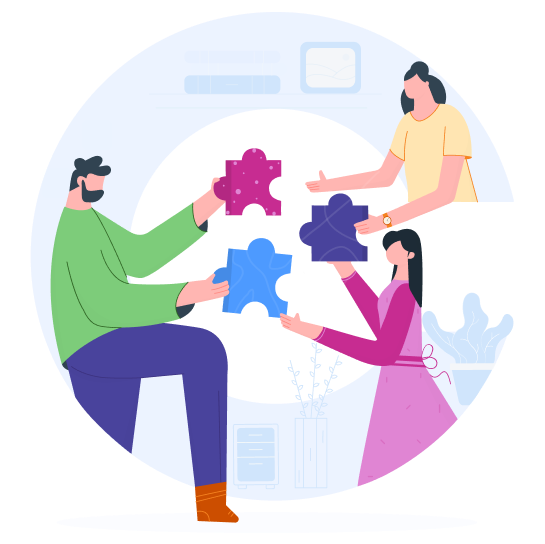

Enterprise application development is the process of building and deploying applications customized to complex business requirements. These applications are usually scalable and help meet business needs.
An asset management application records and tracks assets throughout their life cycle—from procurement to disposal. An organization knows where specific assets are located, details about them, who is using them, and how they are being utilized.

These applications store employee information and support different human resource functions such as recruiting, training, benefits, and payroll. They support human resource management by taking advantage of automation, collaboration, and data.

These apps give companies complete control over every purchase. They consolidate information on purchasing requirements, supplier availability, and purchase order status, creating a unified system that links purchasing activities across departments. The apps foster visibility and transparency in procurement.

Support agents use these apps to help customers. They easily provide answers to questions, help customers troubleshoot technology, give instructions on how to use products, and resolve issues.

Sales representatives use sales apps to market new products and services and to make customers aware of the available discounts and offers. The digital applications help businesses to streamline, optimize, and speed up sales processes. They provide sales reps with tools and features that help them achieve their targets.
An asset management application records and tracks assets throughout their life cycle—from procurement to disposal. An organization knows where specific assets are located, details about them, who is using them, and how they are being utilized.

These applications store employee information and support different human resource functions such as recruiting, training, benefits, and payroll. They support human resource management by taking advantage of automation, collaboration, and data.

These apps give companies complete control over every purchase. They consolidate information on purchasing requirements, supplier availability, and purchase order status, creating a unified system that links purchasing activities across departments. The apps foster visibility and transparency in procurement.

Support agents use these apps to help customers. They easily provide answers to questions, help customers troubleshoot technology, give instructions on how to use products, and resolve issues.

Sales representatives use sales apps to market new products and services and to make customers aware of the available discounts and offers. The digital applications help businesses to streamline, optimize, and speed up sales processes. They provide sales reps with tools and features that help them achieve their targets.
Legacy systems prevent organizations from keeping up with a constantly changing business environment. They are difficult to change and maintain and incompatible with new technologies or new business processes. Over the years, they consume more resources but don’t improve performance. This often results in high costs and increased technical debt.
When business strategies and IT strategies are not aligned, it becomes difficult to achieve business objectives. Solutions that were supposed to help quickly become a burden. Business users may also resort to using risky shadow IT, building applications that fall short of the mark. Aligning business with IT improves productivity and allows teams to develop better applications.
Software developers are in high demand but in short supply. And those employed in organizations aren’t given the opportunity to challenge themselves or enhance their skills. They spend most of their time maintaining legacy systems, building common applications, and debugging and fixing bad code. And as enterprises push them hard to drive digital transformation, they are burning out and quitting.
There is a strong relationship between organizational agility and organizational performance. Inflexible businesses have siloed teams that work separately on application development. This leads to production delays, poor app quality, and higher costs.
Low-code means using a platform that still requires developers, but allows them to work much faster. There is much more drag-and-drop functionality and nothing has to be designed from scratch. But developers still have nearly complete control over what the application will do and how it will function. Many enterprise low-code platforms are also simple enough that a business user can sit next to a developer while they are working to have more co-creation of the application.

No-code means there is no custom coding in app development platform. Everything is drag and drop. It’s all visual and there are no ways to change the basic modules. No code is great if your business users want to create their own applications. It makes for much shorter development timelines. But there may be some lack of features or the ability to customize.


Custom applications are built using sensitive customer and company data that needs to be protected. To ensure the security of the data, an enterprise application development platform should have advanced threat detection, secure firewalls, multiple-factor authentication, reliable password policies, secure data centers, backup and disaster recovery features, HTTPS encryption, and IP login restrictions. Data breaches are damaging to a business, so choose a platform with a security-first outlook.
Enterprise application development tools must be capable of scaling according to business requirements so organizations can keep benefiting from them. The platform you choose should be able to accommodate an exponential increase in data, workload, work modules, and simultaneous users. A development tool that supports huge data streams, including IoT data, is better for business growth.

A good app development platform must integrate with other business systems to improve business processes, making them efficient and controlling costs. It should be a centralized data hub for information and sync data in real time. The platform should comprise modules that interlink data from all departments, allowing users to automate repetitive and tedious processes. It should also support data sharing across departments and help managers and executives make data-driven decisions.

Analytics and reporting features empower decision-makers to analyze and understand process efficiencies and make data-driven decisions. They can use data to gain valuable insights into user behavior and adapt to new market trends. Data can also be used to drive business development and growth.

Most companies now use the cloud, so cloud access is an essential feature of an enterprise application development tool. Software with cloud access allows users to log in from multiple locations. This means they can work whenever it’s most convenient for them. The platform should also have user access controls that restrict access to data for certain users or user groups.

Custom applications are built using sensitive customer and company data that needs to be protected. To ensure the security of the data, an enterprise application development platform should have advanced threat detection, secure firewalls, multiple-factor authentication, reliable password policies, secure data centers, backup and disaster recovery features, HTTPS encryption, and IP login restrictions. Data breaches are damaging to a business, so choose a platform with a security-first outlook.
Enterprise application development tools must be capable of scaling according to business requirements so organizations can keep benefiting from them. The platform you choose should be able to accommodate an exponential increase in data, workload, work modules, and simultaneous users. A development tool that supports huge data streams, including IoT data, is better for business growth.

A good app development platform must integrate with other business systems to improve business processes, making them efficient and controlling costs. It should be a centralized data hub for information and sync data in real time. The platform should comprise modules that interlink data from all departments, allowing users to automate repetitive and tedious processes. It should also support data sharing across departments and help managers and executives make data-driven decisions.

Analytics and reporting features empower decision-makers to analyze and understand process efficiencies and make data-driven decisions. They can use data to gain valuable insights into user behavior and adapt to new market trends. Data can also be used to drive business development and growth.

Most companies now use the cloud, so cloud access is an essential feature of an enterprise application development tool. Software with cloud access allows users to log in from multiple locations. This means they can work whenever it’s most convenient for them. The platform should also have user access controls that restrict access to data for certain users or user groups.